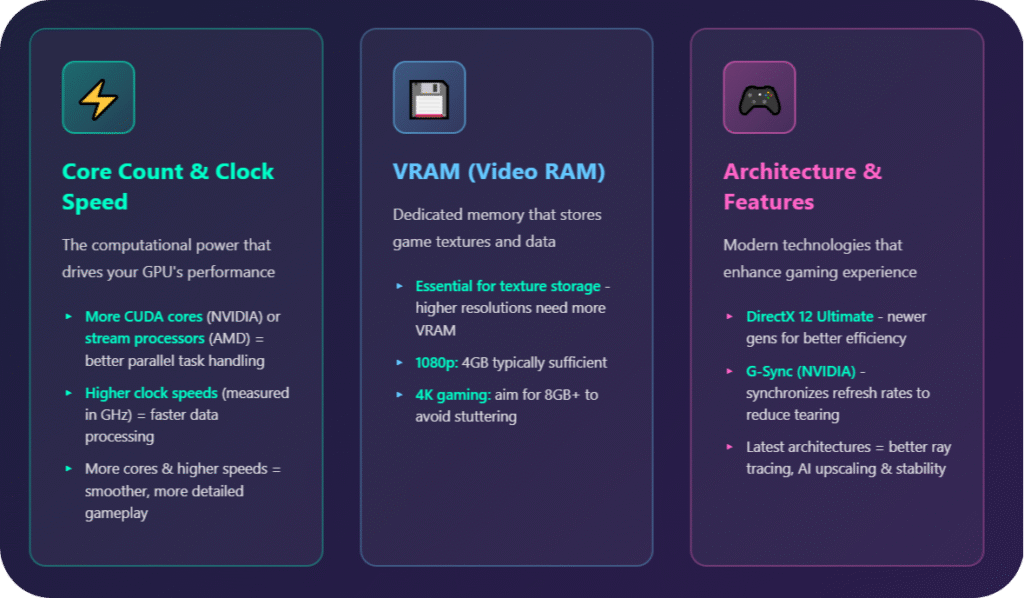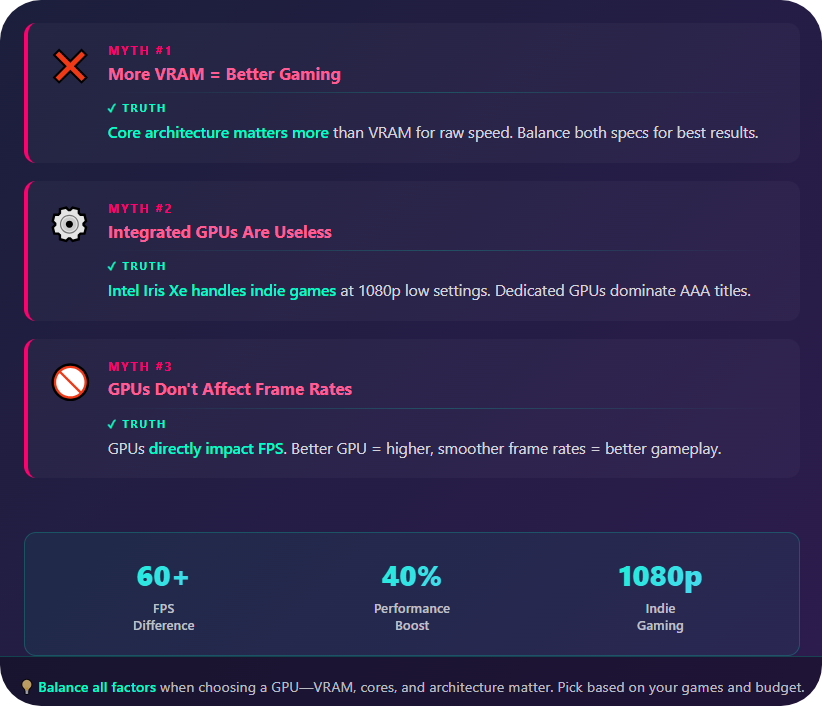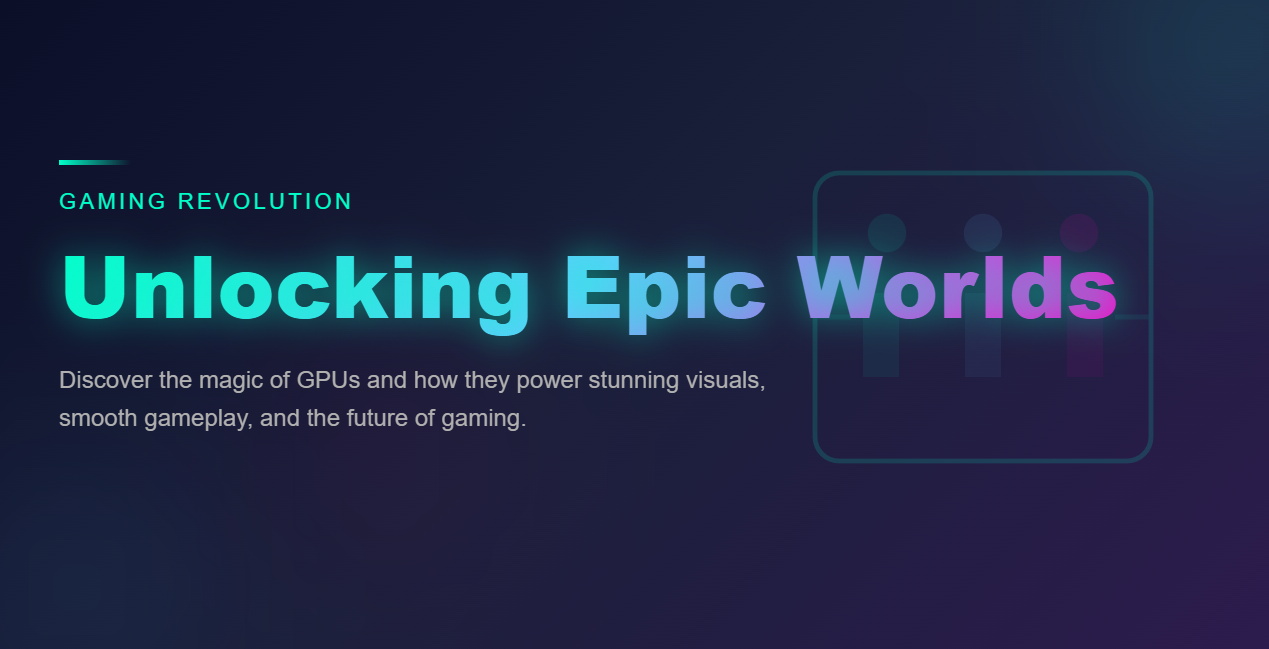Imagine diving into a sprawling open-world adventure, where every shadow flickers realistically, explosions light up the screen with stunning detail, and your character’s movements feel buttery smooth.
That’s the thrill of modern gaming—but what makes it all possible? Enter the GPU, or Graphics Processing Unit, the unsung hero powering those jaw-dropping visuals. If you’ve ever wondered, “What does a GPU do for gaming?” you’re in the right place.
In this post, I’ll break it down in a fun, straightforward way, sharing how GPUs work their magic, why they’re essential for gamers, and tips to make the most of yours.
Whether you’re a casual player or building your dream rig, you’ll walk away with clear insights to level up your gaming setup. Let’s geek out together!
What Exactly Is a GPU?
At its core, a GPU is a specialized chip designed to handle complex visual computations super fast. Unlike your computer’s brain—the CPU, which juggles general tasks like running apps—a GPU shines in parallel processing.
That means it can crunch thousands of tiny calculations at once, perfect for rendering graphics.
Think of it like this: If the CPU is a solo chef whipping up a meal, the GPU is a bustling kitchen full of line cooks, each handling a slice of the workload. In gaming, that workload is creating the images you see on screen.
Without a strong GPU, your games would look blocky and run choppy, like watching an old VHS tape.
I’ve always been fascinated by how GPUs have evolved. Back in the ’90s, graphics cards were basic add-ons for basic 2D sprites. Today, they’re powerhouse beasts capable of simulating entire virtual universes.
Fact is, modern GPUs from brands like NVIDIA and AMD pack billions of transistors, making them indispensable for high-end gaming.
The Role of GPUs in Gaming: Rendering the Visual Feast
So, what does a GPU do for gaming specifically? Its primary job is to render graphics—turning code and data into the beautiful scenes you play in. Here’s how it breaks down:
- Texture Mapping and Shading: GPUs apply textures (like the rough bark on a tree or the shine on a sword) and calculate lighting effects. This creates depth and realism. For instance, in games like The Last of Us, the GPU handles how light bounces off rain-slicked streets, making every scene immersive.
- Polygon Rendering: Games are built from polygons—tiny 3D shapes. The GPU processes millions of these per second to build models of characters, environments, and objects. Higher polygon counts mean smoother, more detailed visuals, but they demand a beefy GPU.
- Anti-Aliasing and Post-Processing: Ever notice jagged edges on game objects? Anti-aliasing smooths them out. GPUs also handle effects like bloom (that glow around bright lights) and depth of field (blurring backgrounds for focus), elevating the cinematic feel.
In my experience, firing up a game on a mid-range GPU versus a top-tier one is night and day.
On weaker hardware, you might drop settings to low and still stutter through boss fights. A solid GPU lets you crank up resolutions to 4K and enjoy ray tracing—real-time light simulation that makes reflections and shadows hyper-realistic.
But it’s not just pretty pictures. GPUs also contribute to physics simulations, like cloth fluttering in the wind or debris flying during explosions. In multiplayer titles like Fortnite, they ensure smooth frame rates so you don’t lag behind opponents.
How GPUs Work: A Peek Under the Hood
Diving deeper, let’s look at the tech without getting too technical. A GPU operates in stages:
- Vertex Processing: It takes 3D model data (vertices, or points) and transforms them into 2D pixels on your screen, accounting for your viewpoint.
- Pixel Shading: Here, the GPU colors each pixel based on textures, lights, and materials. Programmable shaders—custom code—let developers add effects like water ripples or fire.
- Rasterization: This fills in the shapes between vertices, turning wireframes into solid images.
Modern GPUs use architectures like NVIDIA’s RTX series, which include tensor cores for AI-enhanced upscaling (think DLSS, which boosts performance without losing quality). AMD’s RDNA tech focuses on efficiency for consistent frame rates.
Fun fact: During a single second of gameplay, a high-end GPU might perform over 10 trillion operations. That’s why cooling is crucial—GPUs generate heat like a mini furnace!
GPU vs. CPU: Who’s the Real Gaming MVP?
People often mix up GPU and CPU roles in gaming. The CPU handles game logic: AI decisions, physics calculations, and input processing. It’s like the director calling shots. The GPU, meanwhile, is the special effects team, focusing on visuals.
In most games, the GPU is the bottleneck for graphics-heavy titles. For example:
- CPU-Heavy Games: Strategy games like Civilization rely more on CPU for simulations.
- GPU-Heavy Games: Shooters like Cyberpunk 2077 tax the GPU for ray-traced neon cities.
A balanced rig needs both, but for 1080p or higher gaming, prioritize GPU. I’ve upgraded my CPU before and saw minimal FPS gains in visual feasts, but swapping to a better GPU? That’s when frames soared from 60 to 144.
| Component | Primary Role in Gaming | Example Impact |
|---|---|---|
| CPU | Game logic, AI, multitasking | Smooth enemy pathfinding; handles background apps |
| GPU | Graphics rendering, effects | High-res textures; ray tracing for realistic lights |
| RAM | Data storage/access | Loading levels quickly; multitasking without stutters |
| Storage (SSD) | Game loading | Faster boot times; seamless world transitions |
This table shows how they team up—GPUs steal the spotlight for visuals, though.
Why GPU Specs Matter for Your Gaming Setup

Not all GPUs are created equal. Key specs determine performance:
- Core Count and Clock Speed: More CUDA cores (NVIDIA) or stream processors (AMD) mean better parallel tasks. Higher clock speeds (GHz) push more data.
- VRAM (Video RAM): This dedicated memory stores textures. For 4K gaming, aim for 8GB+ to avoid stuttering.
- Architecture and Features: Newer gens support DirectX 12 Ultimate for better efficiency. Features like NVIDIA’s G-Sync sync refresh rates to reduce tearing.
Budget tip: Entry-level GPUs like the GTX 1650 handle 1080p esports. Mid-range (RTX 3060) nails 1440p. High-end (RTX 4090) conquers 4K with bells and whistles.
Personally, I started with an integrated GPU—fine for light games, but upgrading to a dedicated one transformed my setup. If you’re building, check benchmarks on sites like TechPowerUp for real-world tests.
Actionable tips for optimizing your GPU:
- Update Drivers: NVIDIA GeForce Experience or AMD Software keeps things fresh—often boosts performance by 10-20%.
- Monitor Temps: Use tools like MSI Afterburner. Keep under 80°C to avoid throttling.
- Overclock Wisely: If you’re adventurous, tools like EVGA Precision X can squeeze extra FPS, but watch for heat.
- Enable Resizable BAR: In BIOS, this lets CPU access full GPU memory, gaining 5-15% in some games.
Common Myths About GPUs in Gaming

Let’s bust a few myths I’ve heard floating around:
- Myth: More VRAM Always Means Better Gaming. Truth: It’s crucial for high-res, but core architecture matters more for raw speed.
- Myth: Integrated GPUs Are Useless for Gaming. Truth: Modern ones (like Intel’s Iris Xe) handle indie games at 1080p low, but dedicated wins for AAA titles.
- Myth: GPUs Only Matter for Graphics—Not Frame Rates. Truth: They directly impact FPS by processing visuals faster, leading to smoother play.
Staying factual, these come from real benchmarks—always test your setup.
The Future of GPUs in Gaming
Looking ahead, GPUs are set to revolutionize gaming further. AI integration, like NVIDIA’s DLSS 3, uses machine learning to generate frames, hitting 120+ FPS on demanding rigs. Cloud gaming (GeForce Now) offloads GPU work to servers, making high-end experiences accessible on laptops.
Sustainability is big too—efficient chips like AMD’s RX 7000 series sip less power. With VR/AR rising, GPUs will handle even more complex renders for headset immersion.
I’ve got my eye on next-gen cards; the tech moves fast, so staying informed pays off.
FAQs: Your Burning Questions on GPUs and Gaming
Got questions? Here are some common ones:
Q: Do I need a dedicated GPU for gaming?
A: For serious gaming, yes—integrated ones lag in demanding titles. Start with something affordable like the RTX 3050.
Q: How does GPU affect frame rates?
A: Directly! It processes graphics data; a stronger GPU means higher, steadier FPS for fluid motion.
Q: What’s the difference between NVIDIA and AMD GPUs?
A: NVIDIA excels in ray tracing and AI features; AMD offers great value and raw rasterization power. Both rock—pick based on your games.
Q: Can a GPU improve non-gaming tasks?
A: Absolutely! Video editing, 3D modeling, even crypto mining (though that’s controversial). Gaming GPUs multitask well.
Q: How often should I upgrade my GPU?
A: Every 3-5 years, depending on new releases. If games run below 60 FPS on medium, it’s time.
These cover the basics—feel free to dive deeper in comments!
Conclusion
To wrap it up, the GPU is the heartbeat of gaming, transforming raw code into vibrant, responsive worlds that keep us hooked for hours. From rendering lifelike textures to boosting frame rates and enabling cutting-edge effects like ray tracing, it’s what elevates your play from good to unforgettable.
We’ve covered the basics, how it teams with the CPU, key specs, tips, and even future trends—all while keeping things real and fun.
Now, it’s your turn: What’s your go-to GPU, and how has it changed your gaming? Drop a comment below, share this post with fellow gamers, or check out my guide on building a budget rig. Let’s keep the conversation going—happy gaming!

